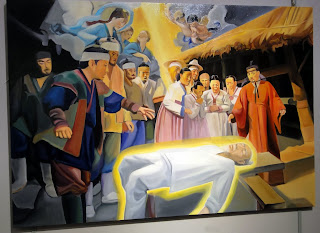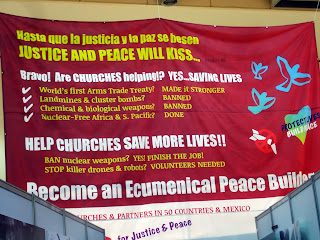The WCC General Assembly has been over for a week now and all the participants have returned home. It is time to take a look at what happened during this Assembly and to share some last impressions.
I spoke about how the opening plenary of the Assembly had a wonderfully creative and artistic presentation of Christianity in Korea.
However, it took us some time to realize that Christianity= Protestantism and excluded Catholicism and Orthodoxy. We could get lost in the spectacular presentation into reading history anachronistically. In point of fact when the first Protestant missionary societies arrived they already found baptized Christian men and women who were living and serving the Gospel as well as giving their lives as witnesses of the truth of the Gospel. These were the first Korean Christians.
 |
| Jeoldusan Martyrs shrine |
The roots of Christianity began with lay people! The Catholic community in Korea came into being when Yi Seung-hun, one among a group of Korean scholars who on their own studied Catholic books and practiced the faith, went to Beijing and was baptized there in 1784. On his return to Korea he spread the Gospel and baptized others. These first Christians like the first generation of followers of Jesus were to suffer martyrdom for their beliefs in Jesus. The first of these began just a few years after the first appearance of Christianity in 1791.
 |
| St Andrew Kim, frist Korean priest |
Here is a link to a brief history of Catholic Christianity in Korea presented by the Bishops' conference to the confessional gathering at Busan.
What is Madang?
Madang is a Korean term meaning a courtyard in a traditional Korean house.
It is a space for encounter and for sharing.
The organizers, aided by the local committee, wanted to present the Assembly under the form of a "shared space for encounter" that would intersect with the five dimensions of being church together: fellowship (koinonia), mission and witness (martyria), service (diakonia), ecumenical formation, and interreligious dialogue and cooperation.
 |
| Cultural presentation |
 |
| Some of the stands at the madang |
To give a flavor of what happened during the assembly here are some pictures of the Madang space and some clips of the cultural and interreligious events that took place.
The madang program was intended to be a place for the exchange of gifts among the participants through workshops, exhibitions, side events, theatre, visual arts and simple a place to relax and discuss.
The Next Seven Years
The experience of the General Assembly has set the program for the WCC for the next seven years. There will be some structural changes in the WCC as well as some new buildings to help better use the properties in Geneva as well as be a stream of income to support the work of the WCC. There will be some serious issues that the Council will have to confront. Some of these could be further church divinding if the churches begin to polarize into camps. Some of the most difficult issues will be the question of ethics and the role of the churches in giving guidance especially to the newer churches and to the Orthodox churches. The documents of the Assembly are mostly available on the WCC web site for those who wish to read the final
statements and the program assembled.
An interesting aspect of the Assembly was the Global Ecumenical Theological Institute (GETI). This was a theological educational program that preceded the Assembly and continued during the Assembly. Approximately 170 young theologians from diverse church traditions participated.
They have affirmed in a letter to the Secretary General of the WCC that they believe in the ecumenical movement and they intend to continue putting into practice what they have studied.. This experiment worked well and the WCC was encouraged to continue the GETI experiment on other occasions. It looks like a new model of ecumenical theological formation may have been born which corresponds to a model of theological education pursued in an ecumenical and dialogical way..
What's coming up in Rome
On Wednesday, 20 November at 6:00 pm, the Centro Pro Unione will have a lecture given by Prof. Alberto Melloni, Professor of the History of Christianity at the University of Modena-Reggio Emilia and Director of the Fondazione per le scienze religiose Giovanni XXIII, Bologna. He will speak on the role that the diaries, letters and films play in the interpretation of the documents of the Second Vatican Council.
On Monday 25 November at 5:30 pm, in collaboration with the publishers of the review Concilium, the Queriniana, the Asian Centre for Cross-cultural Studies, and the Centro Pro Unione will present the volume entitled "Per una riforma della curia romana". The presentation should be a stimulating look at the theological, canonical, historical and ecumenical issues in such an undertaking requested by Pope Francis at the beginning of his Pontificate.
Go to Conferences page of the Centro Pro Unione web site












No comments:
Post a Comment